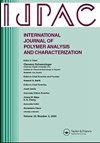纤维素牛油果纤维增强纳米生物填料混纺复合材料的热稳定性及动态力学分析
IF 1.6
4区 工程技术
Q4 POLYMER SCIENCE
International Journal of Polymer Analysis and Characterization
Pub Date : 2023-08-18
DOI:10.1080/1023666X.2023.2251792
引用次数: 0
摘要
摘要研究了稻壳纳米生物填料与环氧树脂复合材料的动态力学和热稳定性。用5 wt处理牛油果生叶纤维。氢氧化钠溶液减少羟基成键的缺点。稻壳纳米填料(RHNFs)与环氧树脂共混,分别以0.25、0.45和0.65 wt对其进行改性。%,分别采用超声和机械搅拌工艺。对制备的样品进行热稳定性、最大降解温度、存储模量(E′)、损耗模量(E″)、阻尼系数(tan δ)和Cole-Cole图的评价。利用EDX光谱法确定了纳米生物填料的元素组成。用扫描电镜(SEM)分析了RHNFs的形貌。热重分析证实0.45 wt。% RHNFs混合硼砂叶纤维(BLF)复合材料表现出优异的热稳定性(371 ~ 384℃)。导数热重法(DTG)分析表明,最大失重降解温度为0.45 wt。RHNFs共混复合材料第一阶段温度为411°C,第二阶段温度为678°C,高于原料和RHNFs共混复合材料(0.25 wt.%和0.65 wt.%)。得到了改进后的E′(959.16 ~ 1637.75 MPa)、E″(90.48 ~ 97.69℃)的玻璃化转变温度(T g)和tan δ(103.35 ~ 109.67℃)的玻璃化转变温度(T g)。由于纳米填料分散性的改善,0.45 wt。通过Cole-Cole图验证了% RHNFs共混复合材料具有均匀的聚合物体系。所分析的复合材料将用于其预期用途的多功能。本文章由计算机程序翻译,如有差异,请以英文原文为准。
Thermal stability and dynamic mechanical analysis of nano-biofillers blended hybrid composites reinforced by cellulosic Borassus flabellifer L. fiber
The aim of this study is to investigate the dynamic mechanical and thermal stability behavior of rice husk nano-biofillers blend epoxy hybrid composites reinforced by Borassus flabellifer L. leaf fiber. The raw Borassus leaf fibers were treated with 5 wt.% NaOH solution to reduce the disadvantages of hydroxyl bonding. Rice husk nano-fillers (RHNFs) were blended with epoxy resin to modify them with 0.25, 0.45, and 0.65 wt.%, respectively, using sonication and mechanical stirring process. The prepared samples were assessed to evaluate the thermal stability, maximum degradation temperature, storage modulus (E′), loss modulus (E″), damping factor (tan δ) and Cole–Cole plot of the composites. EDX spectroscopy was used to confirm the elemental composition of nano-biofillers. The morphology of RHNFs was analyzed using a scanning electron microscope (SEM). The TG analysis confirmed that the 0.45 wt.% RHNFs blended Borassus leaf fiber (BLF) composites exhibited superior thermal stability (371–384 °C). Derivative thermogravimetry (DTG) analysis exposed that the maximum mass-loss degradation temperature of 0.45 wt.% RHNFs blend composites was 411 °C for the first stage and 678 °C for the second stage, which were more than raw and RHNFs blend (0.25 and 0.65 wt.%) composites. Accordingly, improved E′ (959.16–1637.75 MPa), glass transition temperature (T g) from E″ (90.48–97.69 °C) and, T g from tan δ (103.35–109.67 °C) were derived from the modified composites. Owing to the improved dispersion of the nano-filler, the 0.45 wt.% RHNFs blend composites had a homogeneous polymer system, as verified by the Cole–Cole diagram. The analyzed composites are to be used with versatile functionality for their intended purpose.
求助全文
通过发布文献求助,成功后即可免费获取论文全文。
去求助
来源期刊
CiteScore
3.50
自引率
5.30%
发文量
37
审稿时长
1.6 months
期刊介绍:
The scope of the journal is to publish original contributions and reviews on studies, methodologies, instrumentation, and applications involving the analysis and characterization of polymers and polymeric-based materials, including synthetic polymers, blends, composites, fibers, coatings, supramolecular structures, polysaccharides, and biopolymers. The Journal will accept papers and review articles on the following topics and research areas involving fundamental and applied studies of polymer analysis and characterization:
Characterization and analysis of new and existing polymers and polymeric-based materials.
Design and evaluation of analytical instrumentation and physical testing equipment.
Determination of molecular weight, size, conformation, branching, cross-linking, chemical structure, and sequence distribution.
Using separation, spectroscopic, and scattering techniques.
Surface characterization of polymeric materials.
Measurement of solution and bulk properties and behavior of polymers.
Studies involving structure-property-processing relationships, and polymer aging.
Analysis of oligomeric materials.
Analysis of polymer additives and decomposition products.

 求助内容:
求助内容: 应助结果提醒方式:
应助结果提醒方式:


